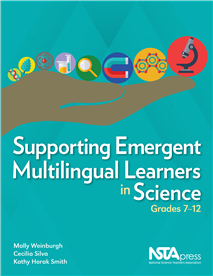All Book Chapters
Book Chapter
In this chapter, reveal is introduced as one component of the 5R Instructional Model. A critical aspect of this “R” is that it supports Emergent Multilingual Learners (EMLs) as they develop language for new concepts using the four modes of the ...
Book Chapter
In this chapter, the role of repeat is examined within the 5R Instructional Model. Repetition is used to provide Emergent Multilingual Learners (EMLs) with multiple opportunities to encounter and express scientific meaning using all of the modes of...
Book Chapter
In this chapter, reposition is introduced as a component of the five Rs.The critical aspect of repositioning is to provide Emergent Multilingual Learners (EMLs) with extended opportunities to assume the complexities of the hybrid language. Reposit...
Book Chapter
In this chapter, the “R” of reload is discussed. The critical aspect of reloading is that it provides Emergent Multilingual Learners (EMLs) with opportunities to revisit words they have previously encountered within a lesson. Reload differs from...
Book Chapter
This chapter brings the work full circle. We provide the voices of teachers who have used the 5R Instructional Model as a tool in developing their own science lessons. Thinking of this model as an overlay when using the learning cycle, these teachers...
Book Chapter
This activity focuses on using magnifiers to look closely at objects. Encourage students to use them in any part of the classroom or outdoors to help in their investigation. Magnifiers should always be kept in the science center as a reminder that it...
Book Chapter
This activity focuses on students looking at their skin, fingernails, hair, and clothes through a magnifier. Give each student a magnifier and ask them to look at their hands through the lens. Listen to their comments to see what they are discovering...
Book Chapter
This activity is about discovering that sunlight shining through a prism produces rainbow colors. Prisms work best in natural light so ask students to place pieces of white paper on the ground and show them how to hold their prisms so that the sunlig...
Book Chapter
This Color Walk activity is to look for objects in the environment that are a particular color. Green is chosen here but other colors may work well too, depending on the season and your location. Pictures may be taken or ask students to draw what th...
Book Chapter
This Shape Walk activity is to look for objects in the environment that are a particular shape. It’s best to choose a shape that will be found often in your environment. A square is a good one to start with, as it is among the most common and one ...
Book Chapter
This activity is about discovering that our eyes need light to see and in order for something to be seen, we need light. The activity works best on a cloudy day when not much sunlight is lighting the room, but make your room as dimly lit as possible....
Book Chapter
This activity uses the sense of sight to find matching objects. Take the students outside and ask them to find some items that look the same as the ones you collected and put in their bags. Back in the classroom, ask them to look at their items with ...
Book Chapter
This activity is for observing and tasting foods that are salty, sour, sweet, or bitter. Give each student a piece of four different foods, such as tortilla chip, pineapple, pickle, and green apple. As children taste each one, encourage a conversatio...
Book Chapter
This activity is for using the sense of smell to observe and identify different scents. At the start, discuss with the students how our sense of smell is very important and can help us identify different objects. Then distribute one set of “smelly ...
Book Chapter
This activity is for sorting flowers based on their scents. Have children arrange their flowers in a Sorting Box with all the flowers that smell on one side and those that don’t on the other side. Ask them to talk more about the sense of smell, wha...



